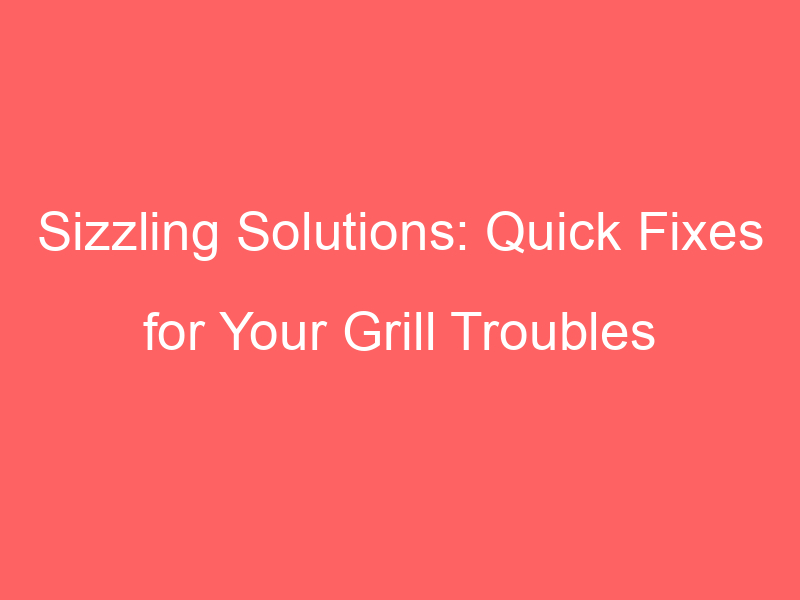Introduction to Grill Troubleshooting
Grilling is an art, and like any other art, it requires a well-maintained tool to achieve the best results. In this case, the tool is your grill. However, grills can sometimes develop issues that can affect their performance. This is where grill troubleshooting comes in. In this section, we will discuss the importance of grill maintenance and common grill issues and their impact.
- Understanding the Importance of Grill Maintenance
- Common Grill Issues and Their Impact
Maintaining your grill is not just about keeping it clean. It’s about ensuring that it performs optimally every time you use it. Regular maintenance can help you identify potential problems before they become serious. For instance, a simple task like checking the gas lines for leaks can prevent a dangerous situation. Moreover, a well-maintained grill can last longer, saving you the cost of frequent replacements.
Grills, like any other appliance, can develop a variety of issues. Some of the most common grill problems include uneven heating, flare-ups, and difficulty in lighting the grill. These issues can significantly affect the quality of your grilled food. For example, uneven heating can result in some parts of your food being overcooked while others are undercooked. Flare-ups can cause your food to be burnt and give it a bitter taste. Difficulty in lighting the grill can delay your cooking process and be a safety hazard.
In the following sections, we will delve deeper into these common grill issues, how to identify them, and how to fix them. We will also share some grill maintenance tips to help you keep your grill in top shape. So, whether you’re a seasoned griller or a beginner, this guide will be a valuable resource for you.
BBQ Troubleshooting: Identifying Common Grill Issues
When it comes to barbecuing, maintaining a consistent temperature is crucial. However, temperature inconsistencies are a common issue that can affect your grilling experience. Let’s delve into this problem and its impact.
Temperature Inconsistencies
Temperature inconsistencies can be a real headache for BBQ enthusiasts. They can lead to unevenly cooked food and can even pose a safety risk. Here are some key points to help you recognize and understand this issue.
- Recognizing temperature fluctuations: It’s important to keep a close eye on your grill’s temperature. If you notice that the temperature is constantly changing, despite setting it at a specific level, you’re dealing with temperature inconsistencies. This can be due to a variety of reasons, such as a faulty thermostat, blocked vents, or even weather conditions.
- Impact on grilling experience: Temperature fluctuations can greatly affect your grilling experience. For instance, if the temperature is too high, your food might burn on the outside while remaining raw on the inside. On the other hand, if the temperature is too low, it can result in undercooked food. This not only affects the taste and quality of your food but can also be a potential health risk.
Understanding these issues is the first step in troubleshooting your BBQ grill. By recognizing temperature inconsistencies and their impact on your grilling experience, you can take the necessary steps to fix the problem and ensure a successful BBQ session.
Stay tuned for more tips on how to identify and fix common grill issues. In the next section, we will discuss ignition problems and their common causes.
Ignition Problems
One of the most common issues you might encounter with your grill is ignition problems. These can prevent your grill from starting properly, or at all. Let’s delve into how to identify these failures and what might be causing them.
- Identifying Ignition Failures
- Common Causes of Ignition Issues
Ignition failures can be quite easy to spot. If your grill refuses to light up despite having a full tank of gas, it’s a clear sign of an ignition failure. Another symptom could be if your grill takes a longer time than usual to ignite. It’s important to address these issues promptly to avoid further damage to your grill.
Ignition problems can be caused by a variety of factors. Here are some of the most common:
| Cause | Description |
|---|---|
| Dirty Igniter | Over time, grease and grime can build up on the igniter, preventing it from sparking properly. |
| Worn Out Igniter | Igniters can wear out over time, especially if your grill is used frequently or is older. |
| Gas Supply Issues | If there’s a problem with your grill’s gas supply, such as a leak or blockage, it can prevent the grill from igniting. |
Understanding the cause of your ignition problems can help you figure out the best way to fix them. Remember, if you’re not comfortable doing the repairs yourself, it’s always best to call a professional.
Grill Repair Guide: Fixing Grill Problems
Grilling is a beloved pastime for many, but it can quickly become frustrating when temperature issues arise. Fortunately, there are some quick fixes you can try to get your grill back in working order. Here are three simple steps to troubleshoot temperature issues with your grill.
Quick Grill Fixes for Temperature Issues
- Checking the Gas Supply
- Examining the Burner Tubes
- Adjusting the Air Shutter
One of the first things you should check if your grill isn’t reaching the right temperature is the gas supply. Make sure your propane tank isn’t empty and that the gas line isn’t blocked or kinked. If you’re using a natural gas grill, check to see if the gas valve is fully open.
Next, take a look at the burner tubes. These can sometimes get blocked with grease or food particles, which can affect the grill’s temperature. You can clean the burner tubes with a wire brush to remove any blockages. Remember to disconnect the gas supply before you start cleaning!
Finally, you may need to adjust the air shutter. This controls the amount of air that mixes with the gas before it’s ignited. If the air shutter is too closed, it can cause the grill to burn too hot. If it’s too open, the grill may not get hot enough. Try adjusting the air shutter to see if it improves the temperature control.
By following these steps, you should be able to quickly fix most common temperature issues with your grill. However, if you’re still having problems, it may be time to consult a professional.
DIY Grill Fixes for Ignition Problems
Ignition problems can be frustrating, but don’t worry, you can fix them yourself. Here are three common ignition issues and how you can solve them:
- Cleaning the Igniter
- Turn off the grill and disconnect it from the gas supply.
- Remove the igniter carefully, making sure not to damage any wires.
- Use a soft brush to clean off any dirt or grime.
- Reinstall the igniter and test it to see if it’s working.
- Replacing the Spark Generator
- First, purchase a replacement spark generator that is compatible with your grill model.
- Disconnect the old spark generator, being careful not to damage any wires.
- Install the new spark generator according to the manufacturer’s instructions.
- Test the grill to see if the new spark generator has fixed the problem.
- Checking the Battery
- Locate the battery compartment on your grill.
- Remove the old battery and check if it’s dead using a battery tester.
- If the battery is dead, replace it with a new one of the same type.
- Test the grill to see if the new battery has solved the problem.
The igniter is a crucial part of your grill, and if it’s dirty, it may not work properly. Over time, grease and grime can build up, preventing the igniter from creating a spark. Here’s how you can clean it:
If cleaning the igniter doesn’t solve the problem, you may need to replace the spark generator. Here are the steps:
Some grills use a battery-powered igniter. If your grill isn’t igniting, the battery might be dead. Here’s how to check:
Remember, safety first. Always turn off and disconnect your grill before performing any maintenance or repairs. If you’re unsure about any of these steps, it’s best to consult a professional.
Solutions for Grill Problems: Grill Maintenance Tips
Keeping your grill in top shape is not as hard as it may seem. With a few simple maintenance tips, you can ensure that your grill lasts for many years and continues to deliver delicious meals. Here are some solutions for common grill problems:
- Regular cleaning of grill components
Cleaning your grill regularly is one of the most effective ways to avoid many common grill problems. Over time, grease and food particles can build up on your grill, leading to issues like uneven heating and flare-ups. To clean your grill, remove the grates and burners and scrub them with a grill brush and soapy water. Make sure to rinse thoroughly and let them dry before reassembling.
- Proper storage of the grill
Proper storage of your grill can also help prevent problems. When not in use, keep your grill covered to protect it from the elements. If possible, store your grill in a dry, sheltered location to prevent rusting and deterioration. Remember to disconnect the propane tank and store it separately if you’re storing your grill for an extended period.
- Periodic checks for gas leaks
For gas grills, it’s important to periodically check for gas leaks. This can be done by applying a light soap and water solution to the hose and turning on the gas. If bubbles form, this indicates a leak that needs to be addressed. Regularly checking for gas leaks can help prevent dangerous situations and ensure your grill operates efficiently.
In conclusion, regular maintenance can help prevent common grill problems and extend the life of your grill. By regularly cleaning your grill components, storing your grill properly, and checking for gas leaks, you can enjoy safe and delicious grilling for years to come.
Barbecue Grill Repair: Case Studies
Learning from real-life situations can be very helpful. Here, we will look at some case studies that will give you a better understanding of how to handle common barbecue grill problems.
Case Study 1: Overcoming Ignition Failures
Ignition failures can be a common issue with barbecue grills. Let’s look at a case where this problem was successfully solved.
- Problem identification:
The grill owner noticed that the grill was not igniting properly. Even after several attempts, the grill wouldn’t light up. This was a clear sign of an ignition failure.
- Steps taken for repair:
The owner first checked the gas tank to ensure it was not empty. Then, they inspected the ignition system and found that the igniter was dirty. The owner cleaned the igniter carefully using a soft brush and then tried to light the grill again.
- Outcome and key takeaways:
After cleaning the igniter, the grill started working perfectly. The key takeaway from this case study is that a dirty igniter can prevent your grill from igniting. Regular cleaning and maintenance can help prevent such issues.
Remember, each grill is unique and may require different troubleshooting steps. However, understanding common problems and their solutions can be a great starting point for any grill owner.
Case Study 2: Solving Temperature Inconsistencies
Let’s dive into our second case study. This time, we’re dealing with a common issue that grill owners face: temperature inconsistencies. This can be a real headache, especially when you’re trying to cook the perfect steak or burger. But don’t worry, we’ve got a solution for you.
- Problem Identification
- Steps Taken for Repair
- Outcome and Key Takeaways
Our grill owner, John, noticed that his grill wasn’t heating up evenly. One side was hotter than the other, causing his food to cook unevenly. This is a common problem known as temperature inconsistency. It can be caused by several factors, such as blocked burner tubes or a faulty regulator.
John started by cleaning the burner tubes, which can often get blocked by grease or food particles. He used a grill brush to scrub the tubes clean. When this didn’t solve the problem, he moved on to checking the regulator. He found that it was faulty and replaced it with a new one.
After replacing the regulator, John noticed a significant improvement in the grill’s temperature consistency. His food was now cooking evenly, much to his satisfaction. This case study highlights the importance of regular grill maintenance and the need to check all parts of the grill when troubleshooting.
Remember, a well-maintained grill not only cooks better but also lasts longer. So, don’t ignore those small issues. They might be signs of a bigger problem. Happy grilling!
| Problem | Solution | Outcome |
|---|---|---|
| Temperature inconsistency | Cleaned burner tubes and replaced faulty regulator | Improved temperature consistency |
Conclusion: Troubleshooting Common Grill Issues
In this guide, we’ve covered a lot of ground on how to troubleshoot common grill issues. Let’s recap what we’ve learned and why it’s important.
- Recap of grill repair guide: We’ve discussed various common grill issues, from uneven heating to gas leaks, and provided step-by-step solutions for each. We’ve also shared some real-life case studies to help you understand the practical application of these solutions.
- Importance of regular grill maintenance: Regular maintenance is key to keeping your grill in top shape. It can prevent many common issues and extend the lifespan of your grill. For example, cleaning your grill regularly can prevent build-up that can cause uneven heating or flare-ups.
- Encouragement for DIY grill fixes: Don’t be intimidated by grill issues. Many common problems can be fixed at home with a little time and patience. Remember, learning to troubleshoot and fix your grill not only saves you money but also enhances your grilling experience.
With the knowledge you’ve gained from this guide, you’re now equipped to handle most common grill issues. So, the next time your grill gives you trouble, don’t panic. Just refer back to this guide, roll up your sleeves, and get to work. Happy grilling!






